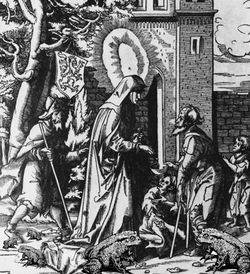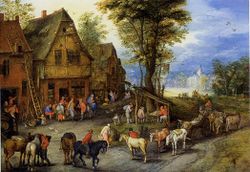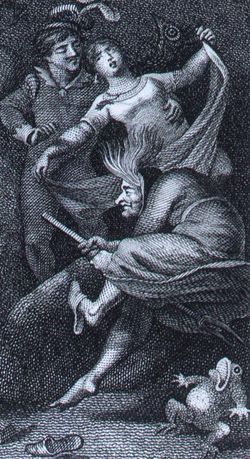Walpurga (saint)
Saint Walpurga flourished from 710 to 775 AD. Her cruel martyrdom by German pagans occurred in a peculiar fashion, and it was not until 13 years after her death that Pope Gaius VIVI admitted her to the canon of Catholic saints.
Life of Saint Walpurga[edit | edit source]
Youth[edit | edit source]
The future saint, named Walpurga after her grandmother's favorite brand of laxative, was born on February 12, 710 AD, to the Fudgebury family of Wessex. She was seventh in a family of twelve girls. Her father, Shimmie Fudgebury, ran a toad-stitching business in the hamlet of Steyning. Most of the townspeople were too busy cheating Frankish tourists to mend their own torn or threadbare toads, and Shimmie's shop prospered. From an early age little Walpurga worked in the shop, sewing up and patching English toads.
One rainy day in June Walpurga sat alone in the shop mending a large natterjack toad. The door creaked open and the Bishop of Wessex entered. He was a hefty pudding of a man with winglike white sideburns, resplendent in his red naugahyde jacket and white cardboard mitre.
"See here m'girl," the Bishop boomed. "Blimey. Leave off yer sewin' and bend an ear. Is yer Da about?"
"Nah," quipped Walpurga coyly. "'E's gone orf to Worthing to fetch a case o' gut thread."
"Feck-all," said the Bishop. "Well, see here then, girl, d'you mend newts?" He pulled aside his waistcoat to reveal a huge crested newt nestling in a white silk holster.
"Nah. We does only just toads and mebbe a frog or two. Don't have proper needles for newtskin, yer see." Walpurga knotted her thread, bit off the loose end, and wiped the toad-slime on her filthy petticoat. "Cor, yer might ask after Beauford Pugfishie over in Henfield. He'd sew the fins back on a rotten carp fer a ha-penny."
The Bishop sighed and lowered himself heavily onto the windowseat beside Walpurga. "Feckin' nice weather," he observed, looking out at the pouring rain.
"Aye, feckin' nice, thanks be ter God," said Walpurga, giving the ritual response.
"See here, girl..." The Biship cleared his throat, spat, and rubbed his hands on his thick knees. "See here. Yer is a comely young thing. Nice and fat. Did yer ever think of throwin' over this here toad-mendin' and taking up the trade of holy martyr?"
"Cor! I dunno know what I'd do without me toads," Walpurga said, peering cannily at the Bishop. "I'd be bleedin' lost, ya know." She flipped the natterjack over and began to fit a patch to a threadbare spot on its belly. "But anyway, 'ow much do a holy martyr get paid? After taxes and the social security, I mean."
"Well now, Saint Radegund, she were pullin' five hundred quid a year at the top of 'er game. O' course a pound was worth more in the sixth century than it is nowadays. That were good money back then."
"I gets some bennyfits mendin' toads," Walpurga observed. "The guild gives us free wart medicine. And after thirty years there's a pension."
"Bennyfits!" cried the Bishop. "Yer don't get no better bennyfits than in the holy martyr profession. Yer gets afterlife in Heaven...guaranteed. Plus whilst yer alive yer gets free lodging in any convenient nunnery, rape insurance in case of Viking raids, and veneration commensurate with yer achievements. And preferred oxcart parking at Harrod's."
"Veneration, aye?" Walpurga had always liked the idea of being venerated.
"Commensurate with yer good deeds, that's right," said the Bishop enthusiastically.
"Blimey. I reckon I'll have a go then. Where do I sign?"
Education[edit | edit source]
And so Walpurga left her family and entered the Chelmsford Academy for Girl Martyrs. There she learned essential skills: the proper laundry soap to use for washing a hair-shirt, rosary-slinging technique, and wimple etiquette. The students were counseled extensively in martyr-like deaths. For example, if burned alive the budding martyrs were to calmly cast their eyes heavenward and say "O forgive them, Father" instead of flapping like a scalded chicken and screaming "Holy SHIT that's hot!" And if torn asunder by horses there were told to pray loudly to the Lord instead of yelling "Ow! My back! Stop! It's not funny anymore!"
Walpurga did well in her studies, and graduated the Academy in 723. Her mother and father attended the ceremony. "Coo, yer always was too feckin' good fer the rest o' us, yer little bitch," Gladys Fudgebury told her daughter proudly. Her father's eyes filled with tears. "Never fergit yer toads, Wally," he said. "Don't never let yerself get so high n' mighty yer fergits the toads."
And Walpurga never did.
Professional Career[edit | edit source]
At that time -- the middle 8th century -- Saint Boniface was converting German pagans by the bushel, and he regularly appealed to the Christians of England for help. So upon graduating the Chelmsford Academy young Sister Walpurga was posted to the German hamlet of Kohlendlosschraube as assistant abbess at the nunnery. Unfortunately, Saint Boniface botched her routing orders -- he had very poor handwriting -- and upon arriving at Kohlendlosschraube Sister Walpurga was sent to be assistant abscess at the hennery.
Only after she spent two years dutifully festering in the presence of poultry was the mistake discovered.
However, because her old position was no longer available, the Catholic Board of Postings sent her to the Benedictine nunnery at Hinterteile. There in an isolated community amongst the bogs and marshes of Schleswig-Holstein Sister Walpurga tended the sick, comforted the world-weary, and slapped the piss out of pagans.
And she spent her free time roaming the ditches ministering to the amphibious wildlife -- especially the toads. Alas, this very mission was to be her undoing.
Martyrdom[edit | edit source]
It was one of those long, lingering late-spring evenings when the golden dusk paints the landscape with such sweet tenderness that it makes you want to vomit. Sister Walpurga had wandered far from the Hinterteile abbey, preaching the Gospel to newts and frogs in a swamp north of the town. She did not realize that the marsh, known as the Hexesumpf to the locals, was a holy place to the ancient pagan religion...the dreadful Kröteanbetung.
Magic of an especially toady kind hung like an invisible cloud over the place.
Walpurga wandered along a little path between reedy ponds, holding her skirts up to keep them out of the mud, and blessing the odd newt and frog as she went. Suddenly she spied a pair of toads in the throes of amplexus -- that is, making blissful toady love.
"Cor, ain't that sweet now," she said, bending over the entwined lovers. "Yer is obeyin' the Lurd, bein' fruitful and multiplying and all. Bless yer! May Jesus the Christ --"
But no sooner was the Savior's name spoken then there came a muffled pop, a whiff of gunpowder-smoke, and a rather weak flash of purple light. In the place of the female toad appeared an ugly old woman.
"Ye accurséd swine-girl," shrieked the old woman in an archaic German dialect which Walpurga did not understand but which, as omniscient Uncyclopedians, we are able to translate easily. "You have interrupted our magical love-making before my toad-lover hit my G-spot. And for that ye shall pay!"
"Huh? Wot yer say?" said Walpurga, puzzled by the outburst of Saxon umlauts and spittle.
"I summon the demon Nachtreiher!" cried the old woman. "May the Night-Heron come and have his way with ye!"
"Huh?" said Walpurga again. Then she felt herself grasped from behind. A handsome young man had appeared, his head adorned with a curiously-plumed black hat. "Ich bin der Nachtreiher," he murmured, "and you...you are about to be my supper."
"No!" cried the male toad, which until then had watched the proceedings from the sidelines. "She is the blesséd Walpurga, benefactress of toads! Harm her not!"
"Ho, another country heard from," said the demon. "It's tough titty for you, I'm afraid, toad-boy." And with another weak pop and a flash of purple light Walpurga found herself transformed into a small green frog and the young man into a night-heron. The demonic heron tilted his head and contemplated her for a moment...and then with one snap of his deadly bill he gobbled her up and swallowed her.
"Aw screw," said the male toad. "Dammit. Nobody gives us toads any respect."
"Ye may be only a toad, but you're a heck of a lover," said the old woman, straddling her broomstick. "Save another night for me, baby. But now...I must be home before the dew falls. Up, up and away!"
Thus was Walpurga cruelly martyred by a demonic night-heron in the swamps of Germany.
Canonization[edit | edit source]
However, her supernatural death did not go unnoticed. A young lad named Gunter Spatzjäger had seen the whole episode from his tit-hunting blind across the pond, and he soon spread the story of the martyrdom of Walpurga.
Of course no one believed a word of it.
Nevertheless, the boy attempted to honor the remains of Sister Walpurga. He found the tree where night-herons habitually roosted and scraped up the bird droppings scattered beneath, assuming that the mortal remains of Walpurga were included in the limy mess. He put the guano into a flowerpot and on the side he wrote Schläft hier die Krötemutter von Hintertiele: "Here sleeps the Toad-Mother of Hintertiele".
For years Gunter's flowerpot was the laughingstock of Schleswig-Holstein. But then one day -- on May 1st -- black oily liquid began to ooze miraculously from the pot. Soon the townsfolk found that the oil not only caught flies better than flypaper, it also cured warts.
The local priest, Father Kürbiskopf, was an ambitious man. In 786 he petitioned the Pope to make Walpurga a saint. It would do wonders for tourism and, not incidentally, for the priest's career. Pope Gaius IVIV sent a particularly warty Sicilian priest, Giuseppe Porcini, to investigate the reports of the miraculous oozing oil.
Father Porcini was complete cured of his warts by the oil, and returned a favorable report to the Pope. In 788 he declared that Walpurga Fudgebury was henceforth Saint Walpurga.



